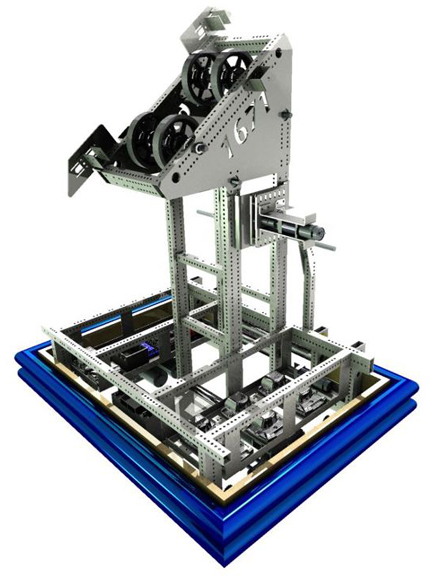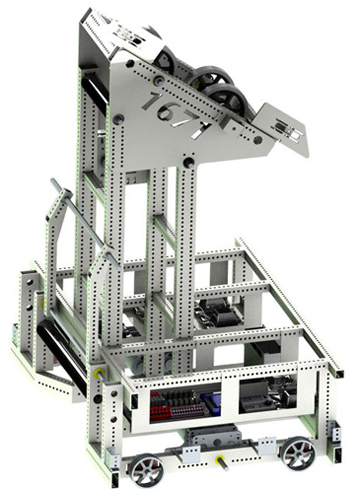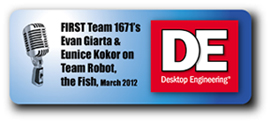Latest News
March 26, 2012
Want to get a robot named after you? You may want to consider volunteering as a mentor to a FIRST robotic team.
Eunice Kokor from FIRST Team 1671 explained the logic behind the name of the team’s fighting spirit, dubbed the Fish. “Each year, we decide to dedicate the robot to someone who has helped us tremendously,” she said. “Last year, we named [the robot] In the House, after our mentor Joshua Houser [from Schneider Electric ], our mentor who helped us with the CAD software [PTC Creo Parametric]. This year, we have ... Nick Fisher. He basically spent his time machining our parts so that we can go back the next day to put our robot together.”
Team 1671, affectionately known as the Buchanan Bird Brains, acknowledged in its home page that Fisher, a veteran employee of Harris Manufacturing, “graciously offered his facilities to our team: he spent an entire weekend machining aluminum parts designed by our team before the Build Stop deadline.”
FIRST is the brainchild of Dean Kamen, an inventor, entrepreneur, and advocate for science and technology. The blend of robotic science and teamwork required to compete in FIRST regional and national championships serve to “inspire young people to be science and technology leaders, by engaging them in exciting mentor-based programs that build science, engineering and technology skills, that inspire innovation, and that foster well-rounded life capabilities including self-confidence, communication, and leadership,” as stated by the organization. Since its launch, the program has become a national phenomenon, growing into the robotic equivalent of the Super Bowl.
Team 1671’s robot, according to the team’s online description, “was assembled, programmed, wired, and designed by the students. Utilizing Creo 1.0, the CAD team contemplated the robot’s desired characteristics of this year’s season that would dictate our success as a team overall. Meanwhile, the programmers got to work on Doc8.cpp using Wind River and Github (their code is available at https://github.com/team1671/DoctorOctagonapus). The electronics team gathered their tools, organized, and created an electronics plate that could easily be applied to the base that would soon be built by the fabrication team.”
CAD and PLM software developer PTC is a strategic partner of FIRST. It provides funding to select FIRST teams, along with special licenses of Creo Parametric, Mathcad, and Windchill to participating teams for free. In addition, it also encourages employees to sign up as mentors to local FIRST teams.
Team 1671’s sponsors for this season include PTC, Roundtable Pizza, Lowe’s, and United States Air Force. Modeled after successful businesses, the team is divided into marketing, communication, CAD design, electronics design, and other departments.Kokor, who serves on the technical division as the team’s CAD and design lead, explained why the use of 3D design software was essential in gearing up the team’s Fish.
“Basically we learned all the different modeling [techniques] and how we can use the tools in the software to mimic [or] imitate what we’ll be doing in real life,” she said. “What we find most useful is in planning, in how we can, down to a quarter of an inch, model what we’re going to do, make sure everything is going to fit within the constraints we were given.”
While FIRST teams are left to their own imagination and ingenuity to determine the shape of their robots, they’re required to keep the robots within the prescribed height, width, and weight limits. Armed with Creo Parametric, Team 1671 was able to create a 3D assembly of their robot, along with subcomponents that must fit within. This gave the technical team a chance to experiment with various configurations of the robot to determine the best possible option.
The team’s CEO Evan Giarta (17, going on 18) added, “The nice thing about Creo is that it allows all users—from beginners to advanced users—to get full utilization out of it.”
The team’s CAD unit, made up of 7-8 members, uses PTC’s PLM software Windchill to archive and manage different versions of the design, often in simultaneous circulation. “[CAD team members] constantly update their parts. From that database, we grab files and use it to create the current version of the robot,” explained Kokor. “Before they’re able to make changes to the robot, they need to make sure they have the current iteration ... [With Windchill,] we’re all on the same page. Nothing changes that we don’t want to.”
Giarta pointed out, “The team also has a couple of large Dropbox shared folders. In some cases—for example, the animation team—they’re dealing with very large audio files and video files. We found that Windchill can accommodate these files on their servers. There’s no limit to it like [there is] on Dropbox, depending on your user status.” (Dropbox, an online file-storage and sharing site, imposes a strict quota on free account holders. Paid members get higher storage capacity.)
The 2012 competition series, dubbed Rebound Rumble, requires robots to perform basketball maneuvers. The rules, according to FIRST’s web site, require that “Each Alliance competes by trying to score as many of the basketballs in the hoops as possible during the 2-minute and 15-second match. Balls scored in higher hoops score Alliances more points. Alliances are awarded bonus points if they are balanced on bridges at the end of the match. In matches where opponent Alliances work together to balance on the white bridge, all participating teams earn additional valuable seeding points.”
In a highly anticipated phase of the game, two robots from allied teams will have to balance themselves on a precarious bridge at the center of the game court. “Our problem with the bridge—we have to be able to move the bridge down so we can get another robot on it,” explained Kokor. “Now, when you have a 120 LB robot, our drivers basically need to fine-tune the motion on the bridge. Any wrong move and your robot could be flying off the bridge.”
Team 1671 uses its Creo CAD software and the digital simulation tools within it to figure out the precise angle of the bridge and to visualize how the robot will behave on the precarious bridge. “We tried out different motions to see how our robot would function,” explained Kokor.
Giarta keeps a blog on PlanetPTC Community site, where he provides periodic updates about the team’s progress. In his last update (posted March 1), he wrote, “Our team is recovering from the build season and preparing for our first regional two weeks from now in Davis, CA. We’re looking forward to proudly displaying and demonstrating our awesome robot and plan to make a splash ... All the the FIRST Robotics Competition teams are now in what may be called the eye of the storm; the initial shock of build season has past, but the deceptive peace right now will soon be interrupted by the chaos of competition. All that can be said now is ... IT’S GAME TIME!”
Team 1671’s robot, the Fish, flexes its metallic muscles in the team’s YouTube video channel, dubbed FRC1671’s Channel.
For more, visit the team’s home page here and listen to an audio interview with Evan Giarta and Eunice Kokor below:
Subscribe to our FREE magazine, FREE email newsletters or both!
Latest News
About the Author
Kenneth Wong is Digital Engineering’s resident blogger and senior editor. Email him at [email protected] or share your thoughts on this article at digitaleng.news/facebook.
Follow DE









